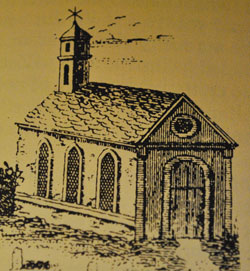
The series will explore words used in the Episcopal Church that may seem arcane to visitors and confusing to old timers. We use them all of the time and never consider their origin. Time to root out our history!
It is ironic that when we invite people into the church and one of the first people they meet may be a “warden”! Are they locking us in until we contribute ? They may hear people talking about “vestries” and questions over “canons”. In old days, there were words like the “glebes” and the “levies” that are rarely heard today. This week’s word is basic – the parish

In our history there are mentions of St. Peter’s being part of St. Mary’s Parish. This was formed in 1677. In 1713, that part of St. Mary’s Parish lying in Richmond Co was added to another parish. When Caroline Co was formed from Essex Co (also King William & King and Queen Co), St. Mary’s Parish went too.
So what is a Parish ? A parish in colonial Virginia was a unit of both civil and religious authority that covered a set geographical territory. Usually covering much less territory than a county, the parish was the layer of government closest to the people, and for many it probably had a greater day-to-day impact on their lives than the county or colony-wide government. Virginia parishes tended to be large – 20- 40 miles long, 5-10 miles wide.

Government ? Remember the church and count government were closely linked prior to the Revolution. As a religious institution, a parish contained a mother, or central, church, and frequently two or more so-called chapels of ease in outlying areas that the minister served on successive Sundays. As a civil institution, the parish vestry was charged with overseeing a wide range of responsibilities that included social welfare and presenting moral offenders to the court (more about that in another week).
Vestries were formally established by the General Assembly in 1642–1643, although these bodies were likely acting to control church affairs by 1635. Parishes were given authority over "all matters concerning the vestry, their agreements with their ministers, touching the church-wardens, the poore and other things concerninge the parish or parishoners respectively be referred to their owne ordering and disposing from time to time as they shall think fitt."
Vestries actually were more powerful than their English equivalents, such as being able to choose their own ministers. They were also closer to the people than the county governnment. In England the parish patron traditionally nominated a minister to become the parish’s rector; the diocesan bishop then inducted the minister into his new role, a position the pastor enjoyed for life barring the commission of gross offenses.
As territorial divisions, the parishes’ bounds were set by Virginia’s General Assembly. They also divided parishes, often at the request of parishioner In the eighteenth century, parishes took on expanded political roles as either power bases for local elites or sources of political controversy within counties. As county populations increased, splitting an old parish could be divisive: one set of residents would gain greater access to religious and welfare services while another set would gain little and have their parish taxes increased.
Gradually after the Revolution power that were attached to the Parishes were taken over by local government even before the Episcopal Chuch was set up. Now the word “Parish” means little except as a gateway to our colonial past but important for researchers and genealogists.
The parish kept key records including registers of parishioners and vestry minutes. This may be their most significant legacy. The registers included birth, baptism and marriage records that are interesting to genealogists. More information about the records here. Virginia Church records are described by FamilySearch, Virginia Family Research and others. St. Peter’s New Kent has an extensive record as well as St. Paul’s reflecting King George and Stafford. There is a general reference – here and here
